
Original Link: https://www.anandtech.com/show/6189/toshiba-excite-77-tablet-review-super-amoled-in-a-fun-size
Toshiba Excite 7.7 Tablet Review: AMOLED in a Fun Size
by Dustin Sklavos on August 29, 2012 2:01 PM ESTIntroducing the Toshiba Excite 7.7
While Toshiba's tablets so far haven't been necessarily bad, like most Android tablets they just haven't really set the world on fire. The only breakthroughs in this market seem to have been ASUS with their Transformers and Amazon's Kindle Fire with its hyper-aggressive pricetag; frankly, the iPad's market stranglehold is a tough nut to crack. That's why I like seeing what Toshiba's up to; most people don't notice when they experiment, but with their Excite line they definitely seem to be doing just that.
Toshiba produced the only 13.3" tablet at the top of the Excite line, but in the smallest form factor, the 7.7", they've gone a different route. The Excite 7.7 eschews the IPS panels most commonly found on tablets in favor of a 1280x800 AMOLED display. The result is a visual experience that's definitely eyecatching compared to other tablets on the market, but can it really justify the $499 starting price?
.jpg)
So here's an interesting question for you: why is the desktop/notebook/case guy handling a tablet review instead of someone like Jason, Anand, Brian, or Vivek? The simple answer is that as someone who doesn't use tablets with any great frequency, I get a slightly different perspective much as Jarred did when he helped review the Acer Iconia A500. This is a big, fresh market that's only going to get bigger with the release of Windows 8; my experience just seeing what HP and Toshiba had in store for that launch is proof enough of that. Just like smartphones have gradually eroded the market for dedicated portable gaming consoles, tablets (and ultrabooks to an extent) have been eating away the market for netbooks. Whether you like it or not, this is the new boss.
With the Excite 7.7, Toshiba is taking the basic foundations of Android tablets and banking on a crucial difference: the AMOLED display. AMOLED is an interesting display technology choice for a tablet; thus far it's been found essentially almost entirely on smartphones, but it has a lot to offer in a bigger size. So while the Excite's 1280x800 resolution isn't necessarily competitive with the substantially higher resolutions of bigger tablets, it makes up for it by having an essentially unmeasurable contrast ratio. When a pixel on an AMOLED display is off, it's off, so there's no calculating a contrast ratio when you have to divide by zero.
| Tablet Specification Comparison | ||||||
| Toshiba Excite 7.7 | Apple iPad (2012) | Amazon Kindle Fire | Samsung Galaxy Tab 8.9 | |||
| Dimensions | 205.7 x 134.6 x 7.6mm | 241.2 x 185.7 x 9.4mm | 190 x 120 x 11.4mm | 230.9 x 157.8 x 8.6mm | ||
| Display | 7.7-inch 1280x800 AMOLED | 9.7-inch 2048 x 1536 IPS | 7-inch 1024 x 600 IPS | 8.9-inch 1280 x 800 PLS | ||
| Weight | 349g | 652g | 413g | 447g | ||
| Processor | NVIDIA Tegra 3 1.3GHz (4 x Cortex A9 + 1 x LP Cortex A9) | Apple A5X (2 x Cortex A9, PowerVR SGX 543MP4) | 1GHz TI OMAP 4430 (2 x Cortex A9) | 1GHz NVIDIA Tegra 2 (2 x Cortex A9) | ||
| Memory | 1GB | 1GB | 512MB | 1GB | ||
| Storage | 16GB | 16GB | 8GB | 16GB | ||
| Pricing | $499 | $499 | $199 | $469 | ||
The Excite 7.7's biggest problem from the get go is that price tag, but note that it's among the thinnest and lightest tablets available, easily besting the Amazon Kindle Fire. Thankfully the $499 MSRP isn't what's materializing in retail; a visit to NewEgg reveals the 32GB model available for $509 while the 16GB model is just $429. That's still a chunk of change, but at least it takes it out of striking distance of the incumbent iPad. Weighing about half as much probably doesn't hurt either.
Specifications on the Excite 7.7 are fairly modest; it's Tegra 3 as we're accustomed to for Ice Cream Sandwich-powered Android tablets and features a 5-megapixel rear camera and a 2-megapixel front-facing camera. Wired connectivity is handled by a micro-USB port, micro-SD slot, and headphone/mic combo jack; wireless is bog standard 802.11b/g/n and Bluetooth 3.0, with no mobile broadband options. The shell itself is attractive, though, with a black finish around the front display, two speakers on the bottom surrounding the charging port, and an etched aluminum backing.
Display
Evaluating the Toshiba Excite 7.7's display has turned out to be more difficult than anticipated, due in no small part to the AMOLED panel used. That difficulty is exacerbated by what Toshiba calls their "AutoBrite" technology. This is a fundamental issue that has been brought up in other reviews of the Excite 7.7 that I've read, and it could very easily be a dealbreaker.
Depending on what's displayed on the Excite 7.7, the screen will dynamically brighten or dim. This isn't the usual ambient light sensor brightness control, this has to do with the content itself, and unfortunately it can get distracting. I suspect it's an "extra mile" to try and optimize what's already a beautiful AMOLED display, but in practice even scrolling through a Facebook page can become slightly annoying when the display pops up a bit, then dims a bit depending on how much white is on what you're looking at. If you're looking at content that's a bit more contrasty and tends towards darker hues more, the display becomes brighter to compensate.
There is no way that I can find to turn this off.
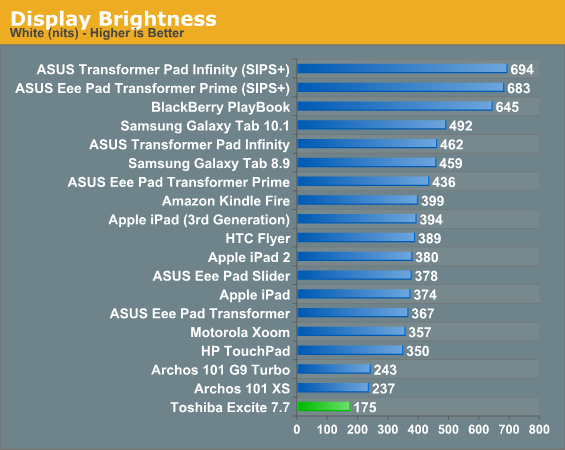
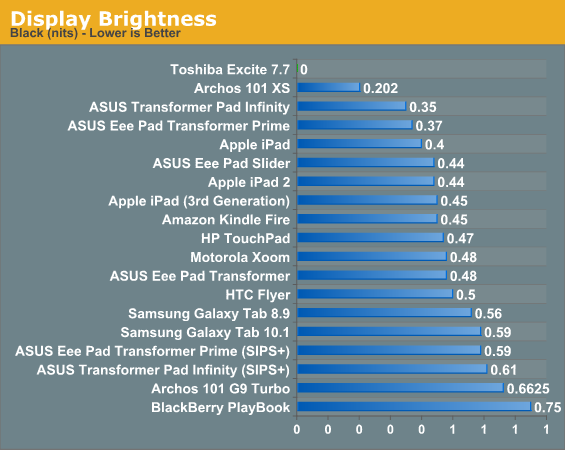
The black level is bulletproof, but I'm ambivalent on the white level. I measured it with the same hardware I use to measure notebook displays, but 175 nits seems extremely low and that's only exacerbated by Toshiba's own dynamic brightness modulation. When I look at the display, it's definitely not 175 nits; eyeballing it I'd say maximum brightness is easily past 300 nits.
With all that said, it's hard not to be wowed by the display. AMOLED technology produces the deepest blacks you're going to get in any kind of portable display, and the colors are equally vibrant and impressive. Even with the brightness adjustments going on, I personally think it's still more desirable than even an IPS display, but your mileage may vary.
Performance
NVIDIA's Tegra 3's performance is already pretty much a known quantity, but it's still impressive to see Tegra 3 stretching its legs in a tablet this small.
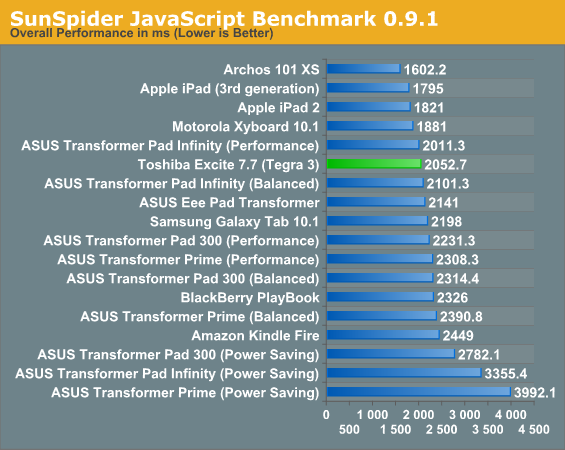
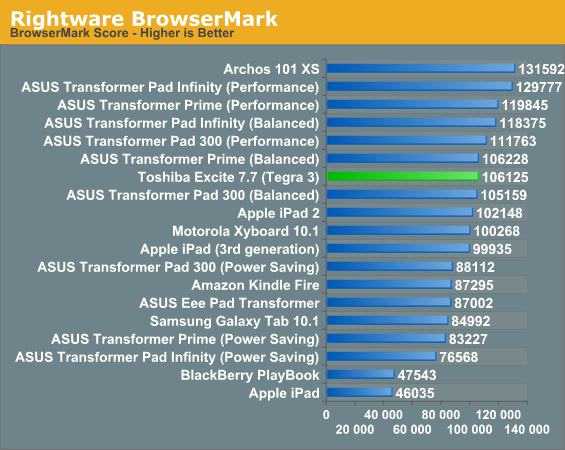
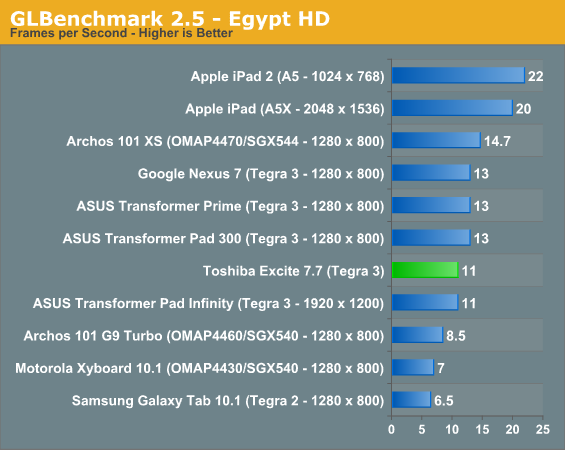
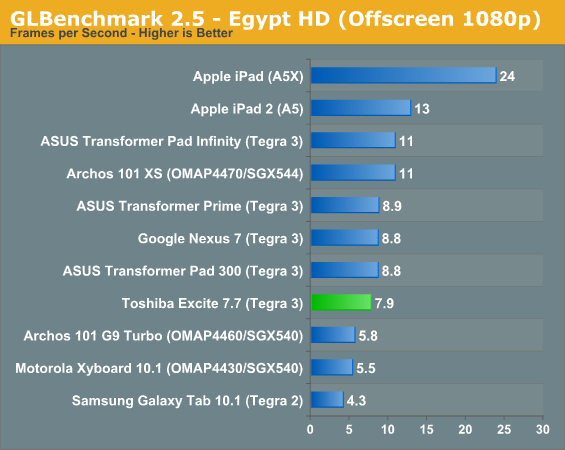
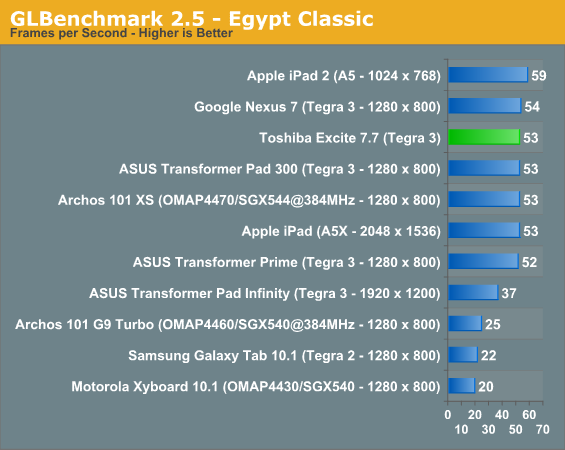
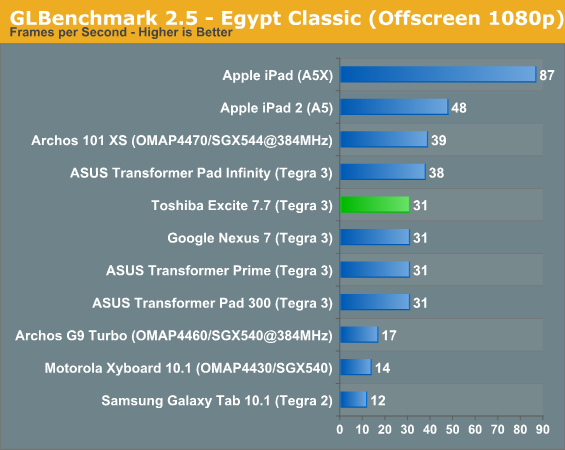
Performance isn't out of the park, but it's definitely competitive with other, larger tablets. You're definitely not making any sacrifices for the form factor here, the Excite 7.7's about as fast as any other Tegra 3-powered tablet out there.
Battery Life
Owing both to its AMOLED technology and just plain smaller display dimensions, the Toshiba Excite 7.7's battery life is pretty stellar for an Android tablet. That said, while we try to measure battery running time with the display set at ~200 nits, the shifting brightness and unreliable calibration readings makes this a much more difficult proposition. As a result I did something essentially unthinkable; I adjusted the brightness by eye.
My desktop monitors are all calibrated to 220 nits (I'm a little bit blind), so I used them as a comparison point for setting the brightness of the Excite 7.7 for battery testing. Even then it's still a ballpark setting for two reasons: the dynamic brightness, and the way AMOLED technology itself works. Dark colors (and blacks) draw less power than a bright colors or a white display do. So while I tested video playback on the Excite 7.7 using a video with the same bitrate, dimensions, and codec as the other guys do when testing their tablets, there's a chance the duller color palette of the horror movie (my horror movie) might have had a slight impact on the results. If you want to see the source material for yourself (shameless plug ahead), you can check it out here.
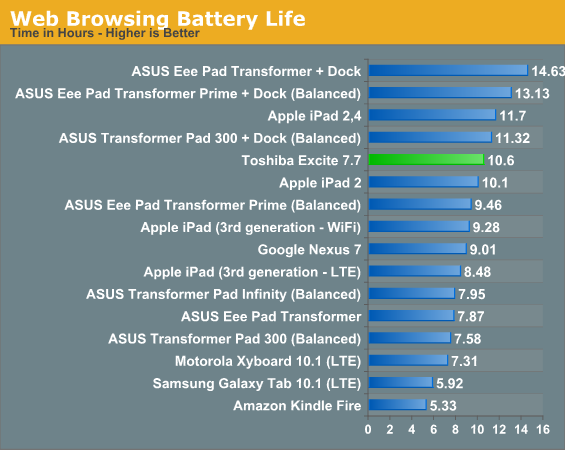
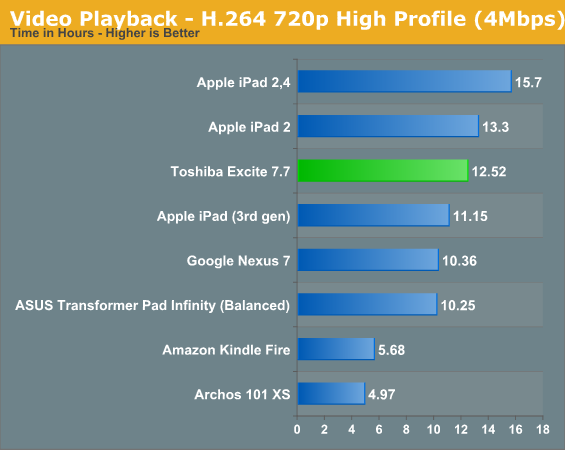
Even with having to eyeball the brightness and the potentially compromised color palette of the video played back, the results speak for themselves: the Excite 7.7 has excellent battery life. Even if you chopped a quarter of the running time off to create a worst case scenario, the Excite 7.7 would still be beating the comparably sized Kindle Fire handily and be roughly competitive with Google's excellent Nexus 7.
Subjective User Experience
If you come to AnandTech for objective product analysis, feel free to skim or skip this section. As someone who relies either on a smartphone or a netbook for most of his portable computing needs, the tablet presents an interesting alternative and I was curious to see how it would fit into my workflow and daily life. My impressions are...mixed.
As a smartphone user I've shied away from getting locked into Apple's closed ecosystem, and my experiences with Android have been less than stellar. Truth be told, I use a smartphone powered by Windows Phone 7.5; Microsoft's smartphone operating system is remarkably clean, functional, and snappy to use, and it's difficult to bog it down the way Android can very easily get. Visually I also find the spartan coloring and design to be more pleasing than Android or iOS, but I also tend to prefer more minimalistic approaches to aesthetics whenever possible. Why is this relevant?
Because I have my doubts about Android as a tablet OS. Android is very busy and not as intuitive as I'd like, and if Windows 8 or Windows RT are going to gain traction with consumers, Metro
.jpg)
What killed the usability for me were two areas: the touchscreen keyboard and the lack of a true wireless data option. Microsoft's Surface and many other Windows 8/RT tablets are liable to fix the issue of the former, but the sluggish oligopoly that is the American wireless market is quickly turning into a boot on the throat of emerging technologies like tablets. Content consumption devices are only as good as their ability to provide content, but by being tethered to WiFi the tablet becomes more of a novelty. Unfortunately that's going to be the case for most users, Toshiba tablet or no, because wireless data plans for tablets are prohibitively expensive, especially when you're already dealing with paying the bill for your smartphone. All of this before you get into the offensively low bandwidth caps American wireless carriers have in place.
As far as smaller tablets go, I do quite like the Excite 7.7 and I've found it moderately useful for doing quick look-ups of things while I'm in front of the TV. It's much easier to pick up a tablet that's less than a pound than it is a three pound netbook. It's just not worth the price of admission, and for people commuting on public transportation in major metropolitan areas (for example, BART in the California bay area), the lack of wireless broadband is a killer. Nine times out of ten, I'm going to prefer my old-fashioned Kindle Keyboard and just read.
Conclusion: If You're In the Market, It's Worth a Look
Without even playing with them you could probably easily argue that the Excite 10 and Excite 13.3 tablets just don't have much to offer an already saturated Android tablet market, but the Toshiba Excite 7.7 is another story entirely. With the Excite 7.7, Toshiba has produced a relatively speedy Android tablet with a knockout screen and an impressively light form factor. Tablet size is bound to be a matter of taste for individual users; some may prefer the increased screen size and real estate of a 10" tablet (Big Buddha knows my eyesight is going and I'll probably be one of those in a decade or so) while others will likely fall over themselves over the Excite 7.7's small-but-still-useful dimensions.
If you're looking for a smaller tablet and price is a primary concern, odds are you've either already clicked "Add to Cart" on the Kindle Fire and are anxiously awaiting its shipment or you're planning on ordering a Google Nexus 7. Google's (and ASUS's) entrant is liable to basically just knock the Kindle Fire right out of competition, but in the process it does take a lot of the shine off of Toshiba's Excite 7.7. It has similar dimensions and weight, and even benefits from a newer version of Android as well as NFC capability.
.jpg)
With those things in mind, though, the existence of the Nexus 7 may wound the Excite 7.7, but it doesn't kill it. Toshiba's tablet sports both superior battery life and a much nicer display, and for some users these factors may very well be enough to warrant the extra money. The dynamic brightness can be on the irritating side, especially with no way to disable it, but it's not quite as bad as it sounds. Personally it was far more frustrating for objective testing than it was for actual use, where it was easy enough to ignore.
I think the Toshiba Excite 7.7 is probably going to wind up being lost in the shuffle, and that's a shame because it's worthy of attention. Toshiba learned a lot from the Thrive and they're clearly willing to experiment a bit with the technology if the AMOLED display is any indication. That display alone may be worth the price of admission; either way, the Excite 7.7 is at least worth considering.

_thumb.jpg)
_thumb.jpg)
_thumb.jpg)
_thumb.jpg)
_thumb.jpg)
_thumb.jpg)






